Mugger crocodile
The mugger crocodile (Crocodylus palustris), also called marsh crocodile, broad-snouted crocodile and mugger, is a crocodilian native to freshwater habitats from southern Iran to the Indian subcontinent. It is extinct in Bhutan and Myanmar and has been listed as Vulnerable on the IUCN Red List since 1982.[2]
| Mugger crocodile Temporal range: late Pleistocene-recent[1] | |
|---|---|
.jpg) | |
| Scientific classification | |
| Kingdom: | Animalia |
| Phylum: | Chordata |
| Class: | Reptilia |
| Order: | Crocodilia |
| Family: | Crocodylidae |
| Genus: | Crocodylus |
| Species: | C. palustris |
| Binomial name | |
| Crocodylus palustris (Lesson, 1831)[2] | |
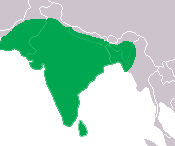 | |
| Distribution of mugger crocodile | |
| Synonyms | |
| |
It is a medium-sized crocodile that inhabits lakes, rivers, marshes and artificial ponds. Both young and adult mugger crocodiles dig burrows where they retreat when temperature drops below 5 °C (41 °F) or exceeds 38 °C (100 °F). Females dig holes in the sand as nesting sites and lay up to 46 eggs during the dry season.[3][4][5] Sex of hatchlings depends on temperature during incubation.[6] It preys on fish, reptiles, birds and mammals. Young feed on insects.[7][8]
It is one of three crocodilians in India, apart from saltwater crocodile (C. porosus) and gharial (Gavialis gangeticus).[9]
Etymology
The Hindi word मगर or मगरमच्छ (Hindi pronunciation: [/məgərəməccʰə/]) means crocodile.[10] The Sanskrit word मकर makar refers to both Capricornus, crocodile and a mythical crocodile-like animal.[11]
In Balochi language, it is called Gando.[12]
Taxonomy
Crocodilus palustris was the scientific name proposed by René Lesson in 1831 who described the type specimen from the Gangetic plains.[13] In subsequent years, several naturalists and curators of natural history museums described zoological specimens and proposed different names, including:
- C. bombifrons by John Edward Gray in 1844 for a specimen sent by the Museum of the Royal Asiatic Society of Bengal to the British Museum of Natural History.[14]
- C. trigonops also by Gray in 1844 for a young mugger specimen from India.[14]
Characteristics
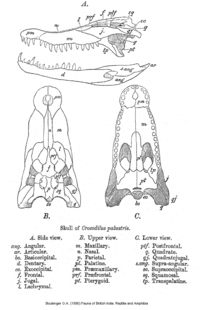

Mugger crocodile hatchlings are pale olive with black spots. Adults are dark olive to grey or brown. The head is rough without any ridges and large scutes around the neck that is well separated from the back. Scutes usually form four, rarely six longitudinal series and 16 or 17 transverse series. The limbs have keeled scales with serrated fringes on outer edges, and outer toes are extensively webbed. The snout is slightly longer than broad with 19 upper teeth on each side. The symphysis of the lower jaw extends to the level of the fourth or fifth tooth. The premaxillary suture on the palate is nearly straight or curved forwards, and the nasal bones separate the premaxilla above.[15]
The mugger crocodile is considered a medium-sized crocodilian, but has the broadest snout among living crocodilians.[5] It has a powerful tail and webbed feet. Its visual, hearing and smelling senses are acute.[3] Adult female muggers are 2 to 2.5 m (6 ft 7 in to 8 ft 2 in) on average, and male muggers 3 to 3.5 m (9 ft 10 in to 11 ft 6 in). They rarely grow up to 5 m (16 ft 5 in). The largest known muggers measured 5.63 m (18 ft 6 in).[3] The largest zoological specimen in the British Museum of Natural History measures 3.7 m (12 ft 2 in).[15] One male mugger caught in Pakistan of about 3 m (9 ft 10 in) weighed 195 kg (430 lb).[16]
Distribution and habitat
_in_Chabahar%2C_Iran-_by_Hadi_Karimi.jpg)
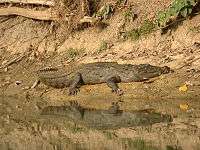
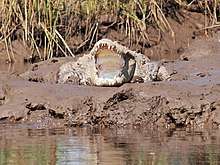
.jpg)
The mugger crocodile occurs in southern Iran, Pakistan, Nepal, India and Sri Lanka, but is probably extinct in Bangladesh.[2] It inhabits freshwater lakes, rivers and marshes, and prefers slow-moving, shallow water bodies. It is also known to thrive in artificial reservoirs and irrigation canals.[5]
In Iran, the mugger occurs along rivers in Sistan and Baluchestan Provinces along the Iran–Pakistan border.[2] On the Iranian Makran coast near Chabahar lives a population of around 200 mugger crocodiles. Due to human activity and a long drought in the late 1990s and early 2000s, it had been pushed to the brink of extinction. Following several tropical cyclones in 2007 and 2010, much of the habitat of the mugger crocodiles has been restored as formerly dry lakes and hamuns were flooded again.[17]
In Pakistan, a small population lives in 21 ponds around Dasht River; in the winter of 2007–08, 99 individuals were counted. By 2017, the population had declined to 25 individuals.[18] In Sindh Province, small mugger populations occur in wetlands of Deh Akro 2 and Nara Desert Wildlife Sanctuaries, near Chotiari Dam, in the Nara Canal and around Haleji lake.[19][20][21]
In Nepal's Terai, it occurs in wetlands of Shuklaphanta, Bardia National Parks, Ghodaghodi Tal and Chitwan National Parks, and in Koshi Tappu Wildlife Reserve.[22][23][24][25]
In India, it occurs in:
- Rajasthan along the Chambal, Ken and Son Rivers, and in Ranthambore National Park[26][27]
- Gujarat along the Vishwamitri River[28]
- Madhya Pradesh's National Chambal Sanctuary[29][30]
- Uttarakhand's Rajaji National Park, Corbett Tiger Reserve and Lansdowne Forest Division[31]
- Uttar Pradesh's Katarniaghat and Kishanpur Wildlife Sanctuaries[32]
- Odisha's Simlipal National Park and along Mahanadi and Sabari Rivers[33][34]
- Telangana's Manjira Wildlife Sanctuary[27]
- Maharashtra's Kadavi and Warna Rivers[35]
- Goa's Salaulim Reservoir, Zuari River and in small lakes[27]
- Karnakata along Kaveri and Kabini Rivers, in the Ranganthittu Bird Sanctuary, Nagarhole National Park and Tungabhadra Reservoir[27]
- Kerala's Parambikulam Reservoir and Neyyar Wildlife Sanctuary[27][36]
- Tamil Nadu's Moyar River and Amaravathi Reservoir[27]
In Sri Lanka, it occurs in several national parks such as Wilpattu, Yala and Bundala National Parks.[5][37] Between 1991 and 1996, it has been recorded in another 102 localities.[38]
Behaviour and ecology
The mugger crocodile is a powerful swimmer that uses its tail and hind feet to move forward, change direction and submerge. It belly-walks, with its belly touching ground, at the bottom of waterbodies and on land. During the hot dry season, it walks over land at night to find suitable wetlands and spends most of the day submerged in water. During the cold season it basks on riverbanks, individuals are tolerant of others during this period. Territorial behaviour increases during the mating season.[3]
Like all crocodilians, the mugger crocodile is a thermoconformer and has an optimal body temperature of 30 to 35 °C (86 to 95 °F) and risks dying of freezing or hyperthermia when exposed to temperatures below 5 °C (41 °F) or above 38 °C (100 °F), respectively. It digs burrows to retreat from extreme temperatures and other harsh climatic conditions.[39]Burrows are between 0.6 and 6 m (2.0 and 19.7 ft) deep, with entrances above the water level and a chamber at the end that is big enough to allow the mugger to turn around.[3] Temperatures inside remains constant at 19.2 to 29 °C (66.6 to 84.2 °F), depending on region.[37]
Hunting and diet
The mugger crocodile preys on fish, snakes, turtles, birds and mammals including monkeys, squirrels, rodents, otters and dogs. It also scavenges on dead animals. During dry seasons, muggers walk many kilometers over land in search of water and prey.[4] Hatchlings feed mainly on insects such as beetles, but also on crabs and shrimp and on vertebrates later on.[7][8] Subadult and adult muggers favour fish, but also prey on small to medium-sized ungulates up to the size of chital (Axis axis).[40] In Bardia National Park, a mugger was observed caching a chital kill beneath the roots of a tree and returning to its basking site. A part of the deer was still wedged among the roots on the next day.[23] They seize and drag potential prey approaching watersides into the water, when the opportunity arises. Adult muggers also feed on turtles and tortoises.[41][42] Muggers have also been observed while preying and feeding on a python.[8] In Yala National Park, a mugger was observed killing a large Indian pangolin (Manis crassicaudata), of which it devoured pieces over several hours.[43]
Tool use
Mugger crocodiles have been documented using lures to hunt birds.[44] This means they are among the first reptiles recorded to use tools. By balancing sticks and branches on their heads, they lure birds that are looking for nesting material. This strategy is particularly effective during the nesting season.[45]
Reproduction
Female muggers obtain sexual maturity at a body length of around 1.8–2.2 m (5.9–7.2 ft) at the age of about 6.5 years, and males at around 2.6 m (8 ft 6 in) body length. The reproduction cycle starts earliest in November at the onset of the cold season with courtship and mating. Between February and June, females dig 35–56 cm (1.15–1.84 ft) deep holes for nesting between 1 and 2,000 m (3.3 and 6,561.7 ft) away from the waterside. They lay up to two clutches with 8 to 46 eggs each. Eggs weigh 128 g (4.5 oz) on average. Laying of one clutch usually takes less than half an hour. Thereafter, females scrape sand over the nest to close it. Males have been observed to assist females in digging and protecting nest sites. Hatchling season is two months later, between April and June in South India, and in Sri Lanka between August and September. Then females excavate the young, pick them up in their snouts and take them to the water. Both females and males protect the young for up to one year.[3][4]
Healthy hatchlings develop at a temperature range of 28–33 °C (82–91 °F). Sex ratio of hatched eggs depends on incubation temperature and exposure of nests to sunshine. Only females develop at constant temperatures of 28–31 °C (82–88 °F), and only males at 32.5 °C (90.5 °F). Percentage of females in a clutch decreases at constant temperatures between 32.6 and 33 °C (90.7 and 91.4 °F), and of males between 31 and 32.4 °C (87.8 and 90.3 °F). Temperature in natural nests is not constant but varies between nights and days. Foremost females hatch in natural early nests when initial temperature inside nests ranges between 26.4 and 28.9 °C (79.5 and 84.0 °F). The percentage of male hatchlings increases in late nests located in sunny sites.[6] Hatchlings are 26–31 cm (10–12 in) long and weigh 75 g (2.6 oz) on average when one month old. They grow about 4.25 cm (1.67 in) per month and reach a body length of 90–170 cm (35–67 in) when two years old.[3]
Sympatric predators
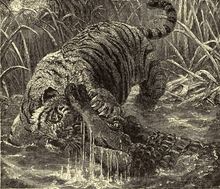
The mugger crocodile is sympatric with the gharial in the river systems of the Ganges, Chambal, Son, Ramganga, Girwa and eastern Mahanadi, as well as in the Rapti and Narayani Rivers.[46][25][29] In a few coastal areas, its distribution overlaps with that of the saltwater crocodile, but it barely enters brackish water and prefers shallow waterways.[5][47][48]
Other sympatric predators of the mugger crocodile include Asiatic lion, dhole, Indian python as well as Burmese and reticulated python in the far eastern parts of the mugger crocodile's range.[5] The Bengal tiger is the only carnivore known to fight mugger crocodiles off prey and even, rarely and if extremely hungry, endeavor to prey upon mugger crocodile adults, such as in Ranthambore National Park.[49] There is also evidence of lion predation on crocodiles on the banks of the Kamleshwar Dam in Gir National Park, during dry, hot months.[50]
Attacks on humans
The mugger crocodile is potentially dangerous to humans. Fatal attacks have been reported, though less frequently than by saltwater and Nile crocodiles. Human victims are dragged into the water and drowned, but are rarely consumed.[51] In the 1990s, several fatal attacks of muggers on humans have been reported in Gujarat, India.[52]
Since large muggers occasionally take livestock, this leads to conflict with local people living close to mugger habitat. In Maharashtra, local people are compensated for loss of close relatives and livestock.[8][53]
Threats
The mugger crocodile is threatened by habitat destruction because of conversion of natural habitats for agricultural and industrial use. As humans encroach into their habitat the incidents of conflict increase. Muggers are entangled in fishing equipment and drown, and are killed in areas where fishermen perceive them as competition.[2]
In Gujarat, two muggers were found killed, one in 2015 with the tail cut off and internal organs missing; the other in 2017, also with the tail cut off. The missing body parts indicate that the crocodiles were sacrificed in superstitious practices or used as aphrodisiacs.[54] Between 2005 and 2018, 38 mugger crocodiles were victims of traffic accidents on roads and railway tracks in Gujarat; 32 died, and five were treated and returned to the wild.[55]
Conservation
The mugger crocodile is listed in CITES Appendix I, hence export of wild-caught specimens is banned.[2] The mugger is protected under Indian law vide the Wildlife Protection Act, 1972 of India, which lists the mugger in Schedule I (as serial 1D of Part II Amphibians and Reptiles).[56]
In captivity
In India, a total of 1,193 captive bred muggers were released to restock populations in 28 protected areas between 1978 and 1992. Production of new offspring was halted by the Indian Government in 1994.[2]
See also
- Crocodiles in India
- List of reptiles of South Asia
References
- Slavenko, A.; Tallowin, O.J.; Itescu, Y.; Raia, P. & Meiri, S. (2016). "Late Quaternary reptile extinctions: size matters, insularity dominates". Global Ecology and Biogeography. 25 (11): 1308–1320. doi:10.1111/geb.12491.
- Choudhury, B.C. & de Silva, A. (2013). "Crocodylus palustris". IUCN Red List of Threatened Species. 2013: e.T5667A3046723.CS1 maint: multiple names: authors list (link)
- Whitaker, R. & Whitaker, Z. (1984). "Reproductive biology of the Mugger (Crocodylus palustris)". Journal of the Bombay Natural History Society. 81 (2): 297–317.
- Whitaker, R. & Whitaker, Z. (1989). "Ecology of the mugger crocodile". Crocodiles, their ecology, management, and conservation (PDF). Gland: IUCN Crocodile Specialist Group. pp. 276–296.
- Da Silva, A. & Lenin, J. (2010). "Mugger Crocodile Crocodylus palustris" (PDF). In Manolis, S. C. & Stevenson, C. (eds.). Crocodiles: Status Survey and Conservation Action Plan (3rd ed.). Darwin: IUCN Crocodile Specialist Group. pp. 94–98.
- Lang, J.W.; Andrews, H. & Whitaker, R. (1989). "Sex determination and sex ratios in Crocodylus palustris". American Zoologist. 29 (3): 935–952. doi:10.1093/icb/29.3.935.
- McCann, C. (1935). "The Mugger (Crocodilus palustris) feeding on large water beetles (Cybister sp.)". Journal of the Bombay Natural History Society. 38: 409.
- Bhatnagar, C. & Mahur, M. (2010). "Observations on feeding behavior of a wild population of marsh crocodile in Baghdarrah Lake, Udaipur, Rajasthan". Reptile Rap. 10: 16−18.
- Singh, L.A.K. & Kar, S.K. (2006). "Status of the Saltwater Crocodile in Orissa: An Overview". Journal of the Bombay Natural History Society. 103 (2–3): 274–285.
- Caturvedi, M. (1970). "मगर". A practical Hindi-English dictionary. Delhi: National Publishing House. p. 567.
- Caturvedi, M. (1970). "मकर". A practical Hindi-English dictionary. Delhi: National Publishing House. p. 566.
- Elfenbein, J. (1985). "Balochi from Khotan". Studia Iranica. XIV (2): 223–238. doi:10.2143/si.14.2.2014651.
- Lesson, R. (1834). "Le Crocodile des Marais". In Bélanger, C.; Geoffroy Saint-Hilaire, I.; Lesson, R.; Valenciennes, A.; Deshayes, G.P.; Guerin, F. E. (eds.). Voyage aux Indes-Orientales par le nord de l'Europe. Zoology. Paris: Bertrand. pp. 305–307.
- Gray, J. E. (1844). "Crocodiles". Catalogue of the tortoises, crocodiles, and amphisbænians, in the collection of the British Museum. London: Trustees of the British Museum. p. 58–63.
- Boulenger, G. A. (1890). "Crocodilus palustris". Fauna of British India. Reptilia and Batrachia. London: Taylor and Francis. p. 5.
- Siddiqui, R.; Jeyamogan, S.; Ali, S. M.; Abbas, F.; Sagathevan, K. A. & Khan, N. A. (2017). "Crocodiles and alligators: Antiamoebic and antitumor compounds of crocodiles". Experimental Parasitology. 183: 194–200. doi:10.1016/j.exppara.2017.09.008.
- Mobaraki, A. & Abtin, E. (2013). "Estimate of Mugger population in Iran". Crocodile Specialist Group Newsletter. 32 (1): 11–21.
- Rahim, A.; Gabol, K.; Ahmed, W.; Manzoor, B. & Batool, A. (2018). "Population assessment, threats and conservation measures of marsh crocodile at Dasht River, Gwadar" (PDF). Pakistan Journal of Marine Sciences. 27 (1): 45–53.
- Chang, M. S.; Gachal, G. S.; Qadri, A. H. & Shaikh, M. Y. (2012). "Bio-ecological status, management and conservation of Marsh Crocodiles (Crocodylus palustris) in Deh Akro 2, Sindh, Pakistan". Sindh University Research Journal (Science Series). 44 (2): 209–214.
- Chang, M. S.; Gachal, G. S.; Qadri, A. H.; Jabeen, T.; Baloach, S. & Shaikh, M. Y. (2012). "Distribution and Population Status of Marsh Crocodiles, Crocodilus palustris in Nara Desert Wildlife Sanctuary (NDWS) Sindh, Pakistan". Sindh University Research Journal (Science Series). 44 (3): 453–456.
- Chang, M. S.; Gachal, G. S.; Qadri, A. H. & Memon, K. (2016). "Physico-Chemical Assessment of Water Quality and its Effects on Marsh Crocodiles, Crocodylus palustris Population in Haleji Lake Wildlife Sanctuary, Thatta, Sindh, Pakistan". Sindh University Research Journal (Science Series). 48 (1): 41–44.
- Bhatt, H.P.; Saund, T.B. & Thapa, J.B. (2012). "Status and Threats to Mugger Crocodile Crocodylus palustris Lesson, 1831 at Rani Tal, Shuklaphanta Wildlife Reserve, Nepal". Nepal Journal of Science and Technology. 13 (1): 125–131. doi:10.3126/njst.v13i1.7451.
- Bhattarai, S. (2016). "Notes on Mugger Crocodile Crocodylus palustris (Lesson, 1831) hunting on Axis axis in Bardia National Park, Nepal". Hyla: Herpetological Bulletin. 2015 (2): 41–44.
- Khatri, T. B. & Baral, H. S. (2012). "Survey of Ghodaghodi Lake Complex for Cotton Pygmy Goose Nettapus coromandelianus and Marsh Mugger Crocodylus palustris". Our Nature. 2012 (10): 137–144.
- Khadka, B. B.; Maharjan, A.; Thapalia, B. P. & Lamichhane, B. R. (2014). "Population Status of the Mugger in Chitwan National Park, Nepal". Crocodile Specialist Group Newsletter. 33 (3): 9–12.
- Nair, T. & Katdare, S. (2013). "Dry-season assessment of gharials (Gavialis gangeticus) in the Betwa, Ken and Son Rivers, India". World Crocodile Conference. Proceedings of the 22nd Working Meeting of the IUCN-SSC Crocodile Specialist Group. Gland: IUCN Crocodile Specialist Group. pp. 53–65.
- Whitaker, R. & Andrews, H. (2003). "Crocodile conservation, Western Asia Region: an update". Journal of the Bombay Natural History Society. 100 (2&3): 432–445.
- Vyas, R. (2012). "Current status of Marsh Crocodiles Crocodylus palustris (Reptilia: Crocodylidae) in Vishwamitri River, Vadodara City, Gujarat, India". Journal of Threatened Taxa. 4 (14): 3333–3341. doi:10.11609/jott.o2977.3333-41.
- Sharma, R.K. & Singh, L.A.K. (2015). "Status of Mugger crocodile (Crocodylus palustris) in National Chambal Sanctuary after thirty years and its implications on conservation of Gharial (Gavialis gangeticus)". Zoo's Print. 30 (5): 9–16.
- Taigor, S.R. & Rao, R.J. (2010). "Habitat features of Aquatic animals in the National Chambal Sanctuary, Madhya Pradesh, India". Asian Journal of Experimental Biological Sciences. 1 (2): 409–414.
- Joshi, R. (2013). "Range extension of mugger crocodile Crocodylus palustris (Lesson, 1831) in upper Ganges and tributaries, lesser Himalayan zone, north India". Journal of Biology and Earth Sciences. 3 (1): 100–109.
- Choudhary, S.; Choudhury, B.C. & Gopi, G.V. (2018). "Spatio-temporal partitioning between two sympatric crocodilians (Gavialis gangeticus & Crocodylus palustris) in Katarniaghat Wildlife Sanctuary, India" (PDF). Aquatic Conservation: Marine and Freshwater Ecosystems. 28: 1–10. doi:10.1002/aqc.2911.
- Sahu, H.; Dutta, S. & Rout, S. (2007). "Survey of Mugger Crocodile (Crocodylus palustris) in Similipal Tiger Reserve, Orissa, India". Tigerpaper. 34 (1): 27–32.
- Debata, S.; Purohit, S.; Mahata, A.; Jena, S.K. & Palita, S.K. (2018). "Mugger Crocodile Crocodylus palustris Lesson, 1831 (Reptilia: Crocodilia: Crocodylidae) in river Saberi of Godavari system in southern Odisha, India: conservation implications". Journal of Threatened Taxa. 10 (6): 11770–11774. doi:10.11609/jott.3974.10.6.11770-11774.
- Patil, S.R.; Atigre, R.H. & Patil, S.V. (2012). "First Record of Mugger Crocodile Crocodylus Palustrius (Lesson, 1831) from River Kadavi at Sarud, Tal, Shahuwadi, Dist. Kolhapur, MS, India". 4th International Conference on Agriculture and Animal Science. 47: 100–104.
- Sivaperuman, C. & Jayson, E. A. (2013). "An assessment of human-crocodile conflicts in Neyyar Wildlife Sanctuary, India". World Crocodile Conference. Proceedings of the 22nd Working Meeting of the IUCN-SSC Crocodile Specialist Group. Gland: IUCN Crocodile Specialist Group. p. 115.
- Whitaker, R.; Barr, B.; de Silva, A. & Ratnasiri, P. (2007). "Observations on burrows dug by mugger crocodiles (Crocodylus palustris) in Bundala National Park, Sri Lanka". Journal of the Bombay Natural History Society. 104 (2): 19–24.
- Santiapillai, C. & de Silva, M. (2001). "Status, distribution and conservation of crocodiles in Sri Lanka". Biological Conservation. 97 (3): 305–318. doi:10.1016/S0006-3207(00)00126-9.
- Lang, J.W. (1987). "Crocodilian behaviour: implications for management". In Webb, G.J.W.; Manolis, S.C.; Whitehead, P.J. (eds.). Wildlife Management: Crocodiles and Alligators. Sydney: Surrey Beatty and Sons. pp. 273–294.
- Vyas, R. (2010). "Mugger (Crocodilus palustris) population in and around Vadodara city, Gujarat state, India". Russian Journal of Herpetology. 17 (1): 43−50.
- Ranjitsh, M. (1989). "Mugger Crocodilus palustris eating Soft-shell Turtle". Journal of the Bombay Natural History Society. 86: 107.
- de Silva, M.; Amarasinghe, A. A.; de Silva, A. & Karunarathna, D. M. S. (2011). "Mugger crocodile (Crocodylus palustris Lesson, 1831) preys on a radiated tortoise in Sri Lanka". Taprobanica: The Journal of Asian Biodiversity. 3 (1): 38−41. doi:10.4038/tapro.v3i1.3232.
- De Silva, A.; Probst, J.; De Silva, P.D.D.S. & Karunarathna, S. (2018). "An incident of a Mugger Crocodile (Crocodylus palustris) devouring a Pangolin (Manis crassicaudata)". Wildlanka. 6 (3): 147–150.
- Dinets, V.; Brueggen, J.C. & Brueggen, J.D. (2013). "Crocodilians use tools for hunting". Ethology, Ecology and Evolution. 1: 74. doi:10.1080/03949370.2013.858276.
- Venugopal, P. D. (2006). "Observations on Mugger Crocodylus palustris Lesson feeding on birds in Ranganthittu Bird Sanctuary, Karnataka, India". Journal of the Bombay Natural History Society. 103 (1): 105.
- Rao, R. J. & Choudhury, B. C. (1992). "Sympatric distribution of gharial and mugger in India". Journal of the Bombay Natural History Society. 89: 312–315.
- Whitaker, R. & Daniel, J. C. (1980). "The status of Indian crocodilians". Journal of the Bombay Natural History Society. 75 (Supplement): 1238−1245.
- Martin, S. (2008). "Global diversity of crocodiles (Crocodilia, Reptilia) in freshwater". Hydrobiologia. 595 (1): 587–591. doi:10.1007/s10750-007-9030-4.
- Pandit, P. K. (2012). "Sundarban Tiger − a new prey species of estuarine crocodile at Sundarban Tiger Reserve, India" (PDF). Tigerpaper. XXXIX (1): 1–5.
- Mitra, S. (2005). "Crocodiles and Other Reptiles". Gir Forest and the saga of the Asiatic lion. New Delhi: Indus. pp. 148–152. ISBN 978-8173871832.
- Sideleau, B. & Britton, A. R. C (2012). "A preliminary analysis of worldwide crocodilian attacks" (PDF). Crocodiles: Proceedings of the 21st Working Meeting of the IUCN–SSC Crocodile Specialist Group. Gland: IUCN/SSC Crocodile Specialist Group. pp. 22–25.
- Vyas, R. (1993). "Recent cases of man-eating by the Mugger (Crocodylus palustris) in Gujarat State". Hamadryad. 18: 48−49.
- Whitaker, N. (2007). Survey of Human/Crocodile Conflict in India, Maharashtra State, December 2007 (PDF). Madras: Madras Crocodile Trust.
- Vyas, R. (2017). "Emergence of a new potential threat to the Mugger (Crocodylus palustris) population of Gujarat State, India" (PDF). Crocodile Specialist Group Newsletter. 36 (4): 16–17.
- Vyas, R. & Vasava, A. (2019). "Mugger Crocodile (Crocodylus palustris) mortality due to roads and railways in Gujarat, India" (PDF). Herpetological Conservation and Biology. 14 (3): 615–626.
- "SCHEDULE I (of Wildlife Protection Act 1972 (as amended))" (PDF). Retrieved 24 June 2020.
External links
| Wikispecies has information related to Crocodylus palustris |
| Wikimedia Commons has media related to Crocodylus palustris. |
- . New International Encyclopedia. 1905.
- "Eight Crocodiles, Two Tortoises, Australian Parrots Seized; Two Held". Mid-Day. 2018.
- "Crocodiles moved from world's tallest statue". BBC News. 2019. Retrieved 2019-01-26.
- "Marsh crocodiles in good condition in Iran". Tehran Times Daily Newspaper. 2018.
- Nelson, D. (2011). "Fifteen-foot Bengali crocodile claims king of jungle title from tiger". The Telegraph.
- Species Crocodylus palustris at The Reptile Database

.jpg)
.jpeg)
.jpg)